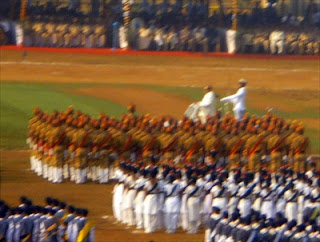Right in the center of the bustling city of Mumbai, the capital of Maharashtra, is a lovely green oasis. Earlier known as the Mahim Nature Park, today it is officially called the Maharashtra Nature Park. Located in the Dharavi-Sion area, at one time it was just a dumping area for garbage, enclosed by vast areas of slums on one side and the polluted Mithi river on the other. You will be surprised to know that now it has plenty of trees and flora and fauna flourish here in abundance. What's more, it even has its own lake!
Maharashtra Nature Park Birds
Black kite
Laughing dove
Barn swallow
Purple sunbird
Bluethroat
Bee eater
Great egret
Maharashtra Nature Park Butterflies
Blue Tiger
Pioneer
Commander
Baronet
Blue Oakleaf
- and lots more!
Maharashtra Nature Park Animals
Squirrels
Mongoose
Bats
Other residents include insects, such as the garden lizard and the chameleon, and reptiles, such as snakes and cobras.
Maharashtra Nature Park Plants
Teak
Rosewood
Flame of the Forest
Golden apple tree
Kadamba
Oak
Lot of flowers!
Maharashtra Nature Park FacilitiesAudio-Visual hall
-
Exhibition hall.
-
Activity spaces for conducting various activities like nature games, drawing or painting competitions
-
Open air Amphitheatre
-
Library of more than 500 books on nature and Environment related topics.
-
Nursery for growing and sale of plants.
Maharashtra Nature Park Sections
Maharashtra Nature Park Activities
(i) Nature Trail
(ii) Nature Games
(iii) Study of Medicinal Plants
(iv) Bird Watching
(v) Seminars/Workshops/Lectures
(vi) Drawing and Essay competitions.
The Park visitors are provided a guide cum interpretation facility on request (for which an advance intimation is necessary).
Maharasthra Nature Park Timings
Monday to Saturday between 0930 hrs. and 1800 hrs. (On Sundays and National Public Holidays too visits are possible, but with prior intimation.)
Maharashtra Nature Park Contact Information
Dy. Director, MNPS, Maharashtra Nature Park Society,
Maharashtra Nature Park,
Near Dharavi Bus Depot,
Opp. P.M.G.P. Colony,
Dharavi,
Mumbai - 400 017.
Maharashtra
Ph: 407 7641/407 9939.
E-mail :
mnps@bom7.vsnl.net.in

























